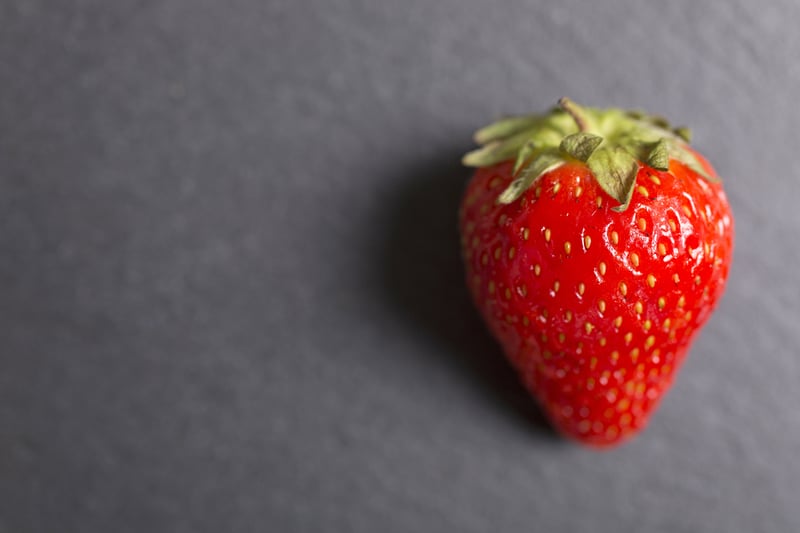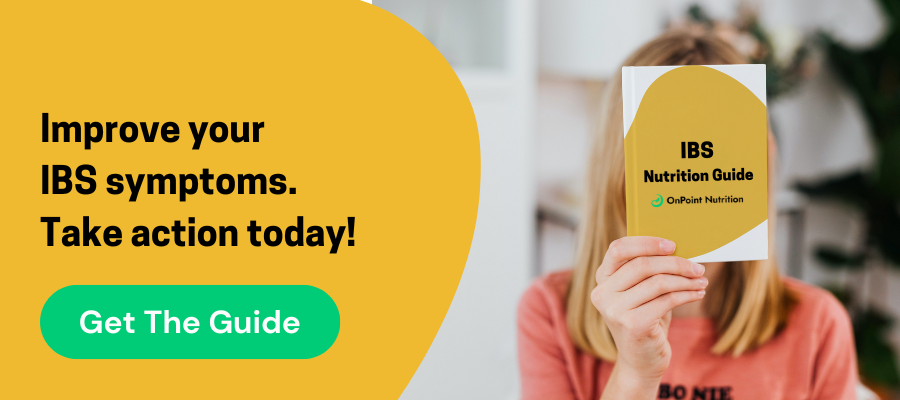
There are various diets you can try if you are trying to manage your IBS symptoms. Read the pros, cons, and our recommendations below:
Low FODMAP
FODMAP is an acronym for fermentable oligo-, di-, and monosaccharides and polyols. In simpler terms, "FODMAP" foods are carbohydrate-containing foods that may cause gastrointestinal discomfort.
In recent years, research has shown that a diet low in FODMAP-containing foods can be helpful as a short-term elimination diet to alleviate symptoms of IBS. Although this is not meant to be a forever diet, temporarily following a low FODMAP diet can potentially provide you long-term relief from IBS by helping identify what foods act as triggers for your IBS symptoms.
There are two steps to the low FODMAP diet:
-
The first step is following a very strict diet that eliminates many foods known to cause IBS. Here is a list of high FODMAP foods to avoid during the elimination phase:
|
Vegetables |
Fruit |
Starch/Nuts |
Condiments |
|
Garlic – avoid entirely if possible Onions – avoid entirely if possible Artichoke Asparagus Baked beans Beetroot, fresh Black eyed peas Broad beans Butter beans Cassava Cauliflower Celery Falafel Fermented cabbage e.g. sauerkraut Haricot beans Kidney beans Lima beans Leek bulb Mange Tout Mixed vegetables Mung beans Mushrooms Peas, sugar snap Pickled vegetables Red kidney beans Savoy Cabbage Soy beans / soya beans Split peas Scallions / spring onions (bulb / white part) Shallots |
Apples including pink lady and granny smith Apricots Avocado Bananas, ripe Blackberries Blackcurrants Boysenberry Cherries Currants Custard apple Dates Figs Goji berries Grapefruit Guava, unripe Lychee Mango Nectarines Paw paw, dried Peaches Pears Persimmon Pineapple, dried Plums Pomegranate Prunes Raisins Canned fruit in apple / pear juice Watermelon |
Wheat containing products such as (be sure to check labels): Biscuits / cookies including chocolate chip cookies Bread, wheat – over 1 slice Breadcrumbs Cakes Cereal bar, wheat based Croissants Crumpets Egg noodles Muffins Pastries Pasta, wheat over 1/2 cup cooked Udon noodles Wheat bran Wheat cereals Wheat flour Wheat germ Wheat noodles Wheat rolls Bread: Multigrain bread Naan Oatmeal bread Pumpernickel bread Roti
Cashews Chestnut flour Cous cous Einkorn flour Freekeh Gnocchi Granola bar Muesli cereal Pistachios Rye Semolina Spelt flour Almond meal Amaranth flour Barley including flour Bran cereals
|
Agave Caviar dip Fructose Fruit bar Gravy, if it contains onion High fructose corn syrup (HFCS) Hummus Honey Jam, mixed berries Jam, strawberry, if contains HFCS Molasses Pesto sauce Relish/pickled vegetables Stock cubes Sugar-free sweets Tahini paste Tzatziki dip |
|
Meat |
Dairy |
Drinks/Protein Powder |
|
Chorizo Sausages |
Buttermilk Cheese, cream Cheese, Halloumi Cheese, ricotta Cream Custard Gelato Ice cream Kefir Milk: Cow milk Goat milk Evaporated milk Sheep’s milk Sour cream Yogurt |
Beer Coconut water Fruit and herbal teas with apple added Fruit juices in large quantities Fruit juices made of apple, pear, mango Kombucha Meal replacement drinks containing milk based products (Ensure, Slim Fast) Orange juice in quantities over 100ml Quinoa milk Rum Sodas containing High Fructose Corn Syrup (HFCS) Soy milk Sports drinks Tea: Black tea Chai tea Dandelion tea Fennel tea Chamomile tea Herbal tea Oolong tea Wine – if drinking more than one glass Whey protein, concentrate unless lactose free Whey protein, hydrolyzed unless lactose free |
- The second part of the diet involves adding previously eliminated foods back into your diet one at a time to identify which foods exacerbate your IBS symptoms. This will give you an idea of what FODMAP foods you are able to eat without experiencing irritation.
Download our IBS Diet Nutrition Guide for more information on a successful Low FODMAP & IBS Diet.
LEAP (Lifestyle, Eating, and Performance)
The "LEAP" stands for Lifestyle, Eating, And Performance protocol. Similar to the low FODMAP diet, LEAP is a standardized elimination-style process used to identify specific food sensitivities.
Here are a few things you should know about the LEAP approach:
- The first step of the LEAP approach is a simple blood test called a Mediator Release Test. This blood test measures how your body reacts in response to certain IBS triggers. When it comes to IBS, there is no "one size fits all" approach. Each person may be more or less sensitive to certain foods. There are 170 different foods identified in the MRT that are classified as 'non-reactive', 'moderately-reactive', or 'reactive'. Because of the test's ability to identify particular "trigger foods", this test can serve as the foundation to an elimination diet.
- After obtaining your MRT results to determine which foods act as specific IBS triggers,your doctor and nutritionist will evaluate your MRT results to determine those foods associated with the lowest inflammatory degree. The foods that prompt the lowest inflammatory response are considered your "best" foods. These foods are least likely to exacerbate your IBS symptoms. Normally, you will begin with a list of 20-25 'non-reactive' foods. You will then work with your team to build a comprehensive eating plan around these "Best" foods. Oxford Medical Technologies, the developers of this approach, publish their results here.
So once I know what my "best" foods are, where do I go from there?
The LEAP diet has 3 phases:
- Phase 1: Consume only your "best foods" identified by the MRT test for 10-14 days. The goal of this phase is to reduce inflammation quickly, relieve IBS symptoms, and create a new baseline before slowly reintroducing foods.
- Phase 2: During this phase, you will reintroduce some of the foods that were identified as "moderately reactive". This phase lasts for 20-35 days and its purpose is to uncover additional foods that do not worsen IBS symptoms. Foods should be reintroduced one at a time and in small amounts. The idea is to only change one variable at a time to be able to identify if that food is what causes the subsequent symptoms, if any.
- Phase 3: Phase 3 is 30-60+ days. I like to think of this phase as the "maintenance" phase. This is meant to be a long-term solution to relieving IBS symptoms as much as possible. The goal is to begin with the foods you have identified in the first two phases as "safe" and continue to reintroduce and "challenge" foods along the way to work your way up to a nutrient-dense, varied diet.
Autoimmune Protocol
The Autoimmune Protocol (AIP) is one of the more restrictive elimination diets used to identify IBS triggers. This relatively new approach aims to eliminate inflammation in the gut by following a diet that excludes all inflammatory foods. Below is a list of foods to be avoided during the elimination phase of AIP.
- Trans fats
- Chemical additives
- Artificial colors and flavorings
- High fructose corn syrup
- Grains
- Pseudograins
- Legumes
- Dairy products
- Processed and refined foods
- Refined sugars
- Sugar substitutes
- Refined vegetable oils
- Eggs
- Nightshade vegetables
- Alcohol
- Coffee
- Nuts/seeds
In order for this approach to work, the diet must be followed for several weeks (3-4 is recommended as the minimum) before slowly reintroducing the eliminated foods. It is recommended to only reintroduce one food every 5-7 days or so. This allows ample time to take note of the body's reaction to a certain food. If reintroducing a food causes a flair-up in your IBS symptoms, the protocol recommends that you permanently avoid that specific food.
Gut and Psychology Syndrome (GAPS)
Similar to the Autoimmune Protocol (AIP), the GAPS diet is extremely restrictive. What differentiates this diet from the rest of the elimination diets is that the process is very time consuming and can take up to two years! There are three stages to the GAPS diet:
- The Introduction Phase: Dr. Campbell McBride, the founder of the GAPS Protocol, suggests that this phase be followed before starting the full GAPS diet. The introduction phase itself has 6 stages, each stage becoming less and less restrictive by adding foods back into the diet. People following the 6 stages are advised to advance to the next stage at their own discretion, some stages may take a few days and others may take longer. In each phase, it is important to allow your body enough time to become adjusted to the foods being added. Below you will find a description of what foods are acceptable in each stage of the introduction phase.
- Stage 1: Homemade bone broth, Boiled meat or fish, well-cooked vegetables, ginger or chamomile tea with raw honey, purified water, and probiotics such as fermented vegetable juices, yogurt or kefir, and homemade fermented whey.
- Stage 2 (add the following foods): raw, organic egg yolks, casseroles made with meats and vegetables, fermented fish, homemade ghee.
- Stage 3 (add the following foods): avocado, sauerkraut and fermented vegetables, scrambled eggs made with ghee, duck fat, or goose fat, probiotic supplements, and GAPS pancakes.
- Stage 4 (add the following foods): roasted or grilled meats, cold-pressed olive oil, freshly pressed carrot juice, and GAPS bread.
- Stage 5 (add the following foods): cooked apple puree, raw vegetables, pressed fruit
- Stage 6 (add the following foods): raw, peeled apple, raw fruit, increase honey, baked goods sweetened with dried fruit
- The Full GAPS diet: After completing the introduction diet, the next step is to move on to the Full GAPS diet. It is recommended that people follow the Full GAPS diet for 1.5-2 years. This diet is extremely restrictive and has a very limited list of acceptable foods. Below is a list of acceptable foods and guidelines to follow during the full GAPS diet.
- Acceptable foods: eggs, meat, fish, shellfish, fruits, vegetables, garlic, olive oil, coconut oil, ghee, a moderate amount of nuts, GAPS baked goods using nut flour.
- Guidelines: Use organic food as often as possible, avoid all processed and packaged foods, eat fermented food with every meal, drink bone broth with every meal, avoid eating fruit with meals, combine all protein foods with vegetables.
- The Reintroduction Phase: Per the GAPS diet protocol, it is imperative that 6 months of normal bowel function must be achieved before moving on to the reintroduction phase. In this phase, certain foods are slowly reintroduced to identify which foods trigger IBS flare-ups. It is recommended to begin with potatoes and fermented grains and then continuing with starchy vegetables, grains, and beans. Slowly reintroduce these foods in small quantities, increasing with absence of digestive issues.
To read more about foods to avoid, foods to eat and how to make easy changes to your IBS diet to mitigate your symptoms, download our IBS Nutrition Guide.

Topics

Kaitlyn Willwerth is a Registered Dietitian at OnPoint Nutrition. Kaitlyn's work focuses on providing individualized health and lifestyle coaching and, most importantly, support. She is a Certified LEAP Therapist and has also completed the Monash University 'Low FODMAP Diet for IBS' online training course for health professionals.



